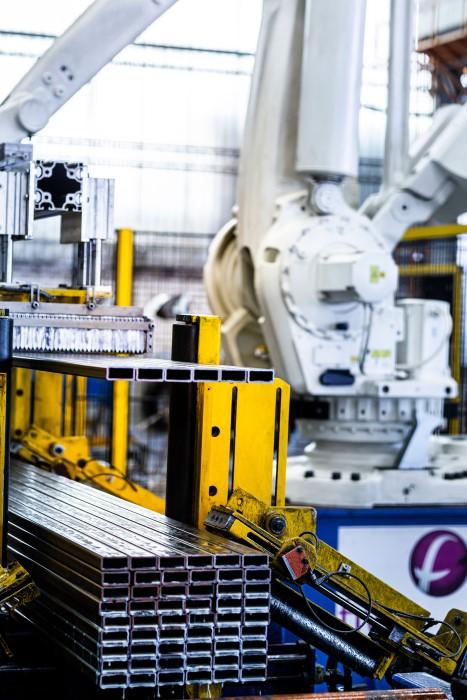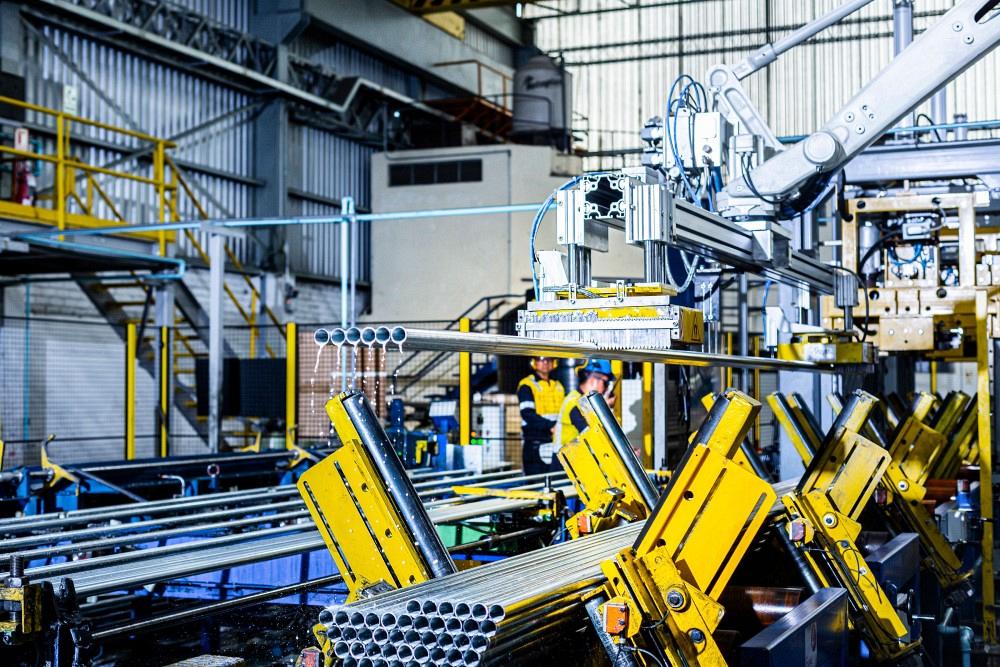Product Manager
- FMA
- The Fabricator
- FABTECH
- Canadian Metalworking
Categories
- Additive Manufacturing
- Aluminum Welding
- Arc Welding
- Assembly and Joining
- Automation and Robotics
- Bending and Forming
- Consumables
- Cutting and Weld Prep
- Electric Vehicles
- En Español
- Finishing
- Hydroforming
- Laser Cutting
- Laser Welding
- Machining
- Manufacturing Software
- Materials Handling
- Metals/Materials
- Oxyfuel Cutting
- Plasma Cutting
- Power Tools
- Punching and Other Holemaking
- Roll Forming
- Safety
- Sawing
- Shearing
- Shop Management
- Testing and Measuring
- Tube and Pipe Fabrication
- Tube and Pipe Production
- Waterjet Cutting
Industry Directory
Webcasts
Podcasts
FAB 40
Advertise
Subscribe
Account Login
Search
The next generation of automated tube and pipe packing
Modular robotic system increases packaging capabilities tube, pipe producers
- By Luca Ferraguti
- July 27, 2021
- Article
- Tube and Pipe Production

To get tube or pipe from a mill line to a bundler, a conventional method is to lift the workpieces with forks and drop them, which is a forceful, noisy process. In redesigning this process, Fives developed Robopack, a pick-and-place system that uses a robot’s chief capabilities to provide a dexterous, deliberate handling and bundling process.
Making a tube or a pipe requires a large amount of equipment, always laid out in a linear fashion. So, when addressing tube packaging challenges, tube makers must deal with plant- and process-dependent layouts, but this is where the utmost flexibility is needed. Tube diameters and cut-off lengths vary, so material handling flexibility is the key to efficiency. Modern technology offers a new way to conceive the tube packing process, smart and simple. Welcome to the age of anthropomorphic robots.
Dedicated to lateral applications for profiles and tubes, a robotically based, versatile system named Robopack from Fives replaces the traditional forks with anthropomorphic robots to pick and place tube to pack hexagonal, square, or rectangular bundles. Because it uses a modular design concept, this system increases flexibility and production, takes less space, improves safety, speeds up changeovers, reduces maintenance costs, reduces noise, and offers fast commissioning, and it does so without compromising quality.
Although robot technology once was novel, niche, and expensive, it has become more widespread, capable, and affordable as it has matured.
Getting a Grip on Modern Technology
The Robopack system comprises modular units arranged according to the customer needs. It is a flexible, versatile packaging system capable of automatically handling profiles and tubes—round and shaped—as small as ¾ in. OD by 10 ft. long (19 mm by 3 m).The system uses an inlet buffer table to store the tubes after being picked up from the runout table. The table is made up of multiple parallel chain units, each one built with ground supports assembled on a large, sturdy frame.
Depending on the layout, a first series of indexing chain receives the tubes unloaded by the cut-off rollway or picks up the tubes directly from the cut-off rollway. For non-round shapes, a sensor located along the indexing chains reads the orientation and, when required, activates a pneumatic tilting device that rotates the tube or profile so that it can be conveyed onto the buffer area horizontally. An additional series of plastic-covered steel chains take the tubes ahead toward the end of the table, creating a storage buffer in front of the robot, properly aligned by a series of product stoppers and pneumatic pushers. Depending on the tube’s OD range, a series of additional devices can be installed to prevent overlapping and excessive bending.
The robot moves the tubes from the buffer area to the forming conveyor using a pick-and-place action, picking up the tubes from the upstream chain and placing them into the downstream bundle formation rollway, creating the bundle with the required shape. This operation involves a variety of manipulations, depending on the tube weight and dimensions.
Just after the forming conveyors, the bundles are handled by an additional set of rollways conveying them to storage and unloading chain conveyors. The storage and unloading conveyors are made of arrangeable modules to fit the tube length, covering the needed runout space and storing the required number of bundles. Shutters chain conveyors can be applied when timber pieces are used.
The interface is user-friendly and easy to customize, providing several features:
- A dynamic visualization of the bundle and buffer table fill level
- Visual recipe and order management
- Strap position calculation
- Control desk tube mill and cutoff integration
- Chat app to communicate among all tube mill workstations
Depending on the tube size and length, package type, and dimension, the production capacity can reach up to 40 tubes per minute in a fully automatic cycle. Compared to a fork-based system, Robopack offers an overall 15% improved performance. This is based on the system’s adaptability to varying operating conditions:
- Smaller packages can be produced without affecting the throughput because the cycle time is not predetermined; it depends on layer size and payload. Reducing the layer size reduces the payload, which reduces the number of pick-and-place cycles to complete each bundle.
- The inlet buffer table allows the system to absorb downstream line stops.
- The system can be scaled up. Changing its performance is a matter of selecting a robot with a greater payload. Picking up a larger number of tubes per cycle reduces the number of cycles to complete a bundle, especially in medium- to large-sized tubes.
- Another option is mini-bundling, which can be done without affecting the system’s performance.
Simple, Flexible, Compact
The essential component in a Robopack is the robot, of course. Robot technology has become so widespread and standardized that robots are available everywhere in the world. Although the availability of robots and peripheral technology varies by country, choosing the best one for the application is a simple matter of comparing the customer’s requirements to the availability.Each manipulator is equipped with a gripper device (or clamp) specifically designed to minimize the weight impact without affecting its stiffness, providing the ability to handle the whole product range while minimizing the tube flexing. Fives developed three different clamping technologies for handling a variety of products, all with dedicated features to guarantee maximum safety in case of a power failure:- Magnet technology for magnetic alloys
- Vacuum technology for stainless steel tubes (ideal for preserving surface quality)
- Mechanical technology for stainless steel tubes (intended for large tubes)
Because it is constructed from small modules, the Robopack system can take up 25% less space than traditional fork-style designs. It can fit easily into normally unused plant spaces, such as the areas between pillars.

For the fastest possible changeovers, the Robopack system from Fives uses a single clamp that can adapt to a variety of tube shapes and sizes.
Beyond space and placement, flexibility is key. The modular design allows the system to be tuned to match any tube format and length with minimal engineering. When necessary, depending on the tube length and storage buffer needed, additional modules can be combined to form a larger buffer table. Moreover, two robots can be put side by side and programmed with coordinated motions to work simultaneously when handling long tubes. The robot payload also can be chosen based on the tube weight, size, and package’s dimensions according to the desired throughput. Beyond these considerations, the system can be integrated with third-party equipment, such as blowing stations, strapping machines, film wrappers, draining and weighing stations, and ticket printers.
Any line upgrade in terms of tube size, tube length, and layout modification can be achieved by adding new modules or increasing the robot size, number of robots, or both. For the same reason, the system effectively lends itself to be redeployed in different lines or configurations by rearranging the existing modules or upgrading them to new ones.
Fundamental Differences From Fewer Moving Parts
Rethinking the tube handling process and developing a new type of system based on robotic technology has resulted in a system that is fundamentally different from conventional fork-based systems and improves how tubes are processed.First, the small, lightweight modules make the installation easier, quicker, and safer than that of a conventional system made from large, bulky components. The time saved in installing and commissioning a system can be as much as 30%.Second, these systems use fewer moving parts than conventional material handling systems. The minimized number of moving parts helps lower maintenance costs compared to a traditional system. And because the design is modular, it comprises a large number of common components, which reduces the variety of spares needed for repairs.
Third, although robots have many moving parts, they come with maintenance plans with known and limited costs, providing the assurances of a mature technology and a standardized product. Finally, parts that require maintenance are easily accessible, reducing the need for skilled labor.
Using a robot as the central element provides a fundamental change in how tube is handled. A fork-based system lifts and drops the tube, which is a forceful, noisy process. Because a robot’s motions can be dexterous and deliberate rather than forceful, the system doesn’t generate as much noise as typical systems, a benefit to the operators. Also, because robots come with a full set of integrated and certified safety modules, the system supports workplace safety goals.
Focused on Product Integrity
Of course, any new manufacturing technology has to provide processes that maintain the product’s integrity. Regarding material handling of tube, among the most critical points is the aesthetic appearance. This system is suitable for stainless steel, automotive, and other applications in which product quality preservation is paramount. The anthropomorphic technology means that the bundle-loading process is carried out in a carefully coordinated pick-and-place process, rather than the more common lift-and-drop fashion.
Furthermore, all tubes’ contact surfaces can be coated by plastic or rubber to prevent scratches, blemishes, and smudging.
About the Author
About the Publication
subscribe now

The Tube and Pipe Journal became the first magazine dedicated to serving the metal tube and pipe industry in 1990. Today, it remains the only North American publication devoted to this industry, and it has become the most trusted source of information for tube and pipe professionals.
start your free subscription- Stay connected from anywhere

Easily access valuable industry resources now with full access to the digital edition of The Fabricator.

Easily access valuable industry resources now with full access to the digital edition of The Welder.

Easily access valuable industry resources now with full access to the digital edition of The Tube and Pipe Journal.
- Podcasting
- Podcast:
- The Fabricator Podcast
- Published:
- 04/16/2024
- Running Time:
- 63:29
In this episode of The Fabricator Podcast, Caleb Chamberlain, co-founder and CEO of OSH Cut, discusses his company’s...
- Trending Articles
Team Industries names director of advanced technology and manufacturing

Orbital tube welding webinar to be held April 23

Chain hoist offers 60-ft. remote control range

Push-feeding saw station cuts nonferrous metals

Corrosion-inhibiting coating can be peeled off after use

- Industry Events
16th Annual Safety Conference
- April 30 - May 1, 2024
- Elgin,
Pipe and Tube Conference
- May 21 - 22, 2024
- Omaha, NE
World-Class Roll Forming Workshop
- June 5 - 6, 2024
- Louisville, KY
Advanced Laser Application Workshop
- June 25 - 27, 2024
- Novi, MI



























